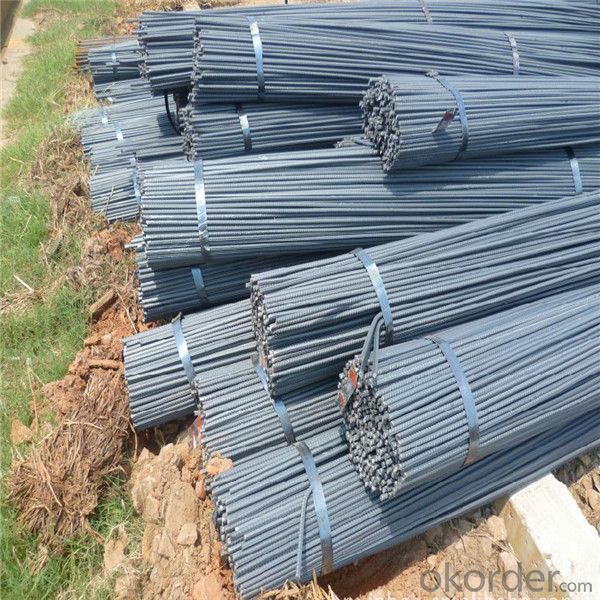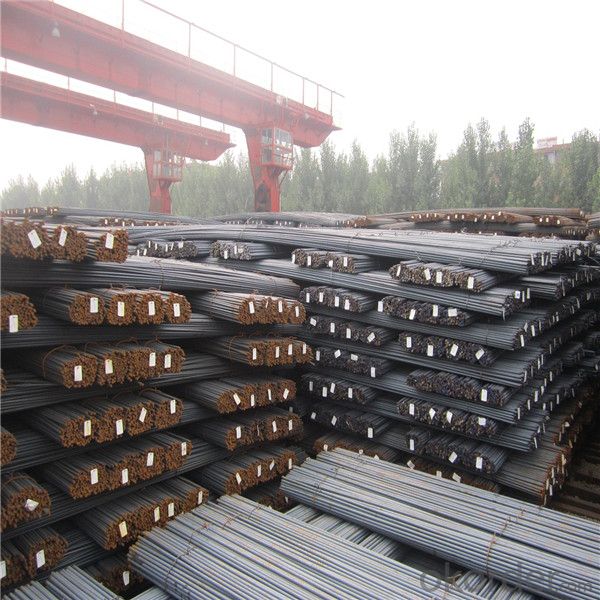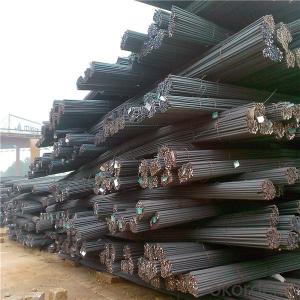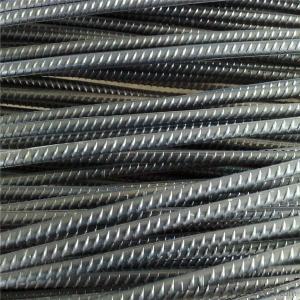Iron Rods For Construction in different grade
- Loading Port:
- Guangzhou
- Payment Terms:
- TT OR LC
- Min Order Qty:
- 100 m.t.
- Supply Capability:
- 18000 m.t./month
OKorder Service Pledge
OKorder Financial Service
You Might Also Like
Item specifice
Deformed Steel bar is a common steel reinforcing bar, used in reinforced concrete and reinforced masonry structures.
It is formed from mild steel, and is given ribs for better frictional adhesion to the concrete. The Deformed Steel bar is
an iron rod , a weldable plain reinforcing steel bar, and can be used as well for steel meshes
Our Advantage: High quality steel products from 1 class mills in China
Reasonable price
Professionalism of the products
On-time delivery
Complete documents and certificates
Sincere service to meet our clients' requirements
Product Description :
Chemical composition (%): | Steel | C | Si | Mn | P | S | Ceq | ||||
HRB335 |
0.25 |
0.80 |
1.60 |
0.045 |
0.045 | 0.52 | |||||
HRB400 | 0.54 | ||||||||||
HRB500 | 0.55 | ||||||||||
Mechanical properties | Steel | Rel/ MPa | Rm/ MPa | A/ % | Agt/ % | ||||||
≥ | |||||||||||
HRB335 | 335 | 455 | 17 |
7.5 | |||||||
HRB400 | 400 | 540 | 16 | ||||||||
HRB500 | 500 | 630 | 15 | ||||||||
Package: | Standard export packing or as customer's request | ||||||||||
Application: | Construction, building, bridge, road. ect | ||||||||||
Payment terms | 1).100% irrevocable L/C at sight. | ||||||||||
Delivery time | 15-30 days after receipt of L/C or deposit by T/T | ||||||||||


Packing:
In bundles, each bundle weight 3.5 tons. Load by container or by bulk verssel.


Our service
(1) We cooperate with famous factories with advanced equipment and well trained workers.
(2) We can provide factory price with trading company service.
(3) We continuously work on the improvement of our processes, guaranteeing consistently high standards
of quality to keep none compensation.
(4) We guarantee 24 hours response and 48 hours solution providing service.
(5) We accept small order quantity before formal cooperation.
(6) We deliver the agreed quality at the agreed time, reacting to changes in customer wishes in a flexible way.
(7) Due to our volume and selling power, we have excellent freight rates with shipping lines.
(8) We strive to always be fair and honest in our dealings with customers.
(9) We strive to work together with customers to achieve much more than we can achieve alone.
(10) Through our passion and commitment we aim to be a market leader in all our key markets. To maintain
our position as market leader we must continue to add value in all that we do.
FAQ:
1.Q: What's your MOQ(minimum order quantity)?
A: One full container, mixed acceptable .
2. Q: What's your packing methods?
A: Packed in bundle or bulk ..
3. Q: How can I buy CNBM products in my country?
A:Please send us an inquiry or email ,we will reply to you if there is distributor in your country
4. Q: Can we visit your factory?
A: Warmly welcome. Once we have your schedule, we will arrange the professional sales team to follow up your case.
5. Q: How long does it take to get the product if i place an order?
A:With the process of your requirements,we will pack and deliver in 3-7 days. If it is by sea shipment,it will take 15-45 days depending on different locations
- Q:How are steel rebars protected against galvanic corrosion?
- Steel rebars are protected against galvanic corrosion through various methods such as applying protective coatings, using sacrificial anodes, and implementing cathodic protection systems. These measures help prevent the corrosion caused by the galvanic reaction between the steel and the surrounding environment, ensuring the longevity and durability of the rebars in concrete structures.
- Q:How do steel rebars help in preventing cracks in concrete structures?
- Steel rebars help in preventing cracks in concrete structures by providing reinforcement and increasing the tensile strength of the concrete. Concrete is strong in compression but weak in tension, and when subjected to external forces or changes in temperature, it tends to crack. However, by embedding steel rebars within the concrete, the tensile forces are transferred to the rebars, preventing the concrete from cracking. The rebars act as a skeleton within the concrete, distributing the tension forces evenly and preventing the formation of large cracks. This reinforcement also helps to control the size and width of any cracks that do occur, minimizing their impact on the overall structural integrity. Moreover, steel rebars help in preventing cracks by improving the ductility of the concrete. Ductility refers to the ability of a material to deform without breaking. The steel rebars provide flexibility to the concrete, allowing it to undergo small deformations without cracking. In addition, steel rebars also help in preventing cracks by reducing the effects of shrinkage and expansion. Concrete tends to shrink as it dries and expands when exposed to high temperatures. These shrinkage and expansion forces can lead to cracking, but the presence of steel rebars helps to counteract these effects by absorbing and distributing the forces. Overall, steel rebars play a crucial role in preventing cracks in concrete structures by reinforcing the concrete, increasing its tensile strength, improving its ductility, and countering the effects of shrinkage and expansion. This reinforcement ensures the structural integrity and durability of the concrete, making it more resistant to cracking and enhancing its overall performance and longevity.
- Q:What is the sign of steel rebar
- Standards are the uniform rules for repeating things and concepts. It is based on the comprehensive achievements of science, technology and practical experience, and is approved by the competent authority and issued in a specific form by consensus by the parties concerned, as a criterion and basis for common compliance.
- Q:What are the different grades of steel rebars used in bridge construction?
- In bridge construction, different grades of steel rebars are used based on the specific requirements and load-bearing capacities of the structure. The most commonly used grades of steel rebars in bridge construction are: 1. Grade 40: This is the lowest grade of steel rebar used in bridge construction. It has a minimum yield strength of 40,000 pounds per square inch (psi). Grade 40 steel rebars are typically used for lighter loads and smaller bridge structures. 2. Grade 60: This is the most commonly used grade of steel rebar in bridge construction. It has a minimum yield strength of 60,000 psi. Grade 60 steel rebars are suitable for medium to heavy loads and are commonly used in bridge piers, girders, and deck slabs. 3. Grade 75: This grade of steel rebar has a minimum yield strength of 75,000 psi. Grade 75 steel rebars are utilized for heavy loads and large bridge structures where higher strength is required. They are commonly used in the construction of high-rise bridges and long-span structures. 4. Grade 80 and Grade 100: These are high-strength steel rebars with minimum yield strengths of 80,000 psi and 100,000 psi, respectively. These grades of steel rebars are used in specialized bridge construction projects that require exceptional strength and durability. They are commonly used in the construction of cable-stayed bridges and suspension bridges. It is important to note that the selection of the appropriate grade of steel rebar for bridge construction depends on various factors such as anticipated loads, span length, design specifications, and local building codes. Consulting with structural engineers and following the recommended guidelines ensures the appropriate grade of steel rebar is used to ensure the safety and longevity of the bridge structure.
- Q:How do steel rebars contribute to the overall fire resistance of a structure?
- Steel rebars contribute to the overall fire resistance of a structure by providing strength and stability. When exposed to high temperatures during a fire, steel rebars do not combust or lose their structural integrity easily. Instead, they retain their load-bearing capacity, preventing the collapse of the structure. Additionally, the thermal conductivity of steel helps in dissipating heat, reducing the spread and intensity of the fire within the building.
- Q:Are steel rebars easy to bend and shape?
- No, steel rebars are not easy to bend and shape as they are typically made of strong and rigid materials, making them resistant to deformation.
- Q:How do steel rebars affect the overall seismic performance of buildings?
- Steel rebars play a crucial role in enhancing the overall seismic performance of buildings. They improve the structural integrity and strength of concrete, which is especially important during earthquakes. By reinforcing the concrete, rebars help to distribute the seismic forces more uniformly, reducing the likelihood of structural failure. Additionally, rebars increase the ductility and flexibility of the building, allowing it to absorb and dissipate seismic energy, thus minimizing the damage caused by the earthquake. Therefore, steel rebars significantly contribute to the improved seismic performance and safety of buildings.
- Q:Are there any alternatives to steel rebars?
- There are multiple options available instead of steel rebars. One such option is the utilization of fiber-reinforced polymer (FRP) rebars, which consist of high-strength fibers embedded in a polymer matrix. FRP rebars present various advantages over traditional steel rebars, such as resistance to corrosion, high tensile strength, and lightweight characteristics. Moreover, they are non-magnetic and electrically non-conductive, making them appropriate for areas with concerns regarding electromagnetic interference. Another alternative is the employment of basalt rebars, which are manufactured from fibers derived from basalt rock. Basalt rebars offer similar benefits to FRP rebars, including corrosion resistance and high tensile strength. Furthermore, certain manufacturers have developed alternative materials like bamboo, carbon fiber, and glass fiber rebars, which have also displayed potential in specific applications. Nevertheless, it is crucial to consider that the selection of alternative rebars depends on the specific requirements of a project, and factors like cost, availability, and adherence to local building codes should be taken into account when choosing an alternative to steel rebars.
- Q:Can steel rebars be used in high-strength concrete?
- Yes, steel rebars can be used in high-strength concrete. In fact, steel rebars are commonly used to reinforce concrete structures, regardless of the concrete strength. High-strength concrete refers to concrete that has a compressive strength significantly higher than conventional concrete. It typically has a compressive strength of 6,000 psi (pounds per square inch) or more. Steel rebars are essential in high-strength concrete to provide the necessary tensile strength. While concrete has excellent compressive strength, it is relatively weak in tension. By incorporating steel rebars into the concrete, the composite material becomes stronger and more durable. The rebars act as reinforcement, resisting the tensile forces and preventing cracks or failure in the structure. However, it is important to note that the selection of the appropriate steel rebar for high-strength concrete is crucial. The rebars used should have sufficient strength and ductility to withstand the higher stresses and strains associated with high-strength concrete. Additionally, proper placement, spacing, and anchorage of the rebars are essential to ensure effective reinforcement and optimal performance of the concrete structure. In summary, steel rebars can definitely be used in high-strength concrete to enhance its tensile strength and overall structural integrity.
- Q:What is the impact of steel rebars on the sustainability of a structure?
- The sustainability of a structure is significantly influenced by steel rebars. To begin with, the usage of steel rebars improves the structure's durability and longevity. Steel is an incredibly durable material that can withstand harsh weather conditions, seismic activities, and heavy loads. Consequently, structures reinforced with steel rebars have a longer lifespan, reducing the need for frequent repairs or replacement. Moreover, steel rebars contribute to the structural integrity of a building. By reinforcing concrete, they help prevent cracks and fractures, ensuring the stability and safety of the structure. This, in turn, diminishes the risk of structural failure, which can have disastrous consequences. Regarding sustainability, the use of steel rebars also promotes resource efficiency. Steel is highly recyclable, with a recycling rate exceeding 90%. Consequently, at the end of a structure's life, the steel rebars can be easily recycled and reused, thereby reducing the demand for new steel production. This not only conserves natural resources but also decreases energy consumption and greenhouse gas emissions associated with steel production. Additionally, the use of steel rebars allows for flexibility in design and construction. They can be easily shaped and bent to meet specific structural requirements, resulting in more efficient use of materials and decreased waste. This flexibility also enables the construction of intricate and innovative structures, fostering architectural diversity and creativity. Lastly, steel rebars offer fire resistance, which is crucial for the safety of a structure and its occupants. Steel does not burn or contribute to the spread of fire, providing a higher level of fire resistance compared to other materials. This feature enhances the overall sustainability of a structure by reducing the risk of fire-related damage and loss. In conclusion, steel rebars positively impact the sustainability of a structure. They enhance durability, contribute to structural integrity, promote resource efficiency through recycling, enable flexibility in design and construction, and provide fire resistance. These factors collectively enhance the lifespan, safety, and environmental performance of a structure, making steel rebars a crucial component for sustainable construction.
1. Manufacturer Overview |
|
|---|---|
| Location | |
| Year Established | |
| Annual Output Value | |
| Main Markets | |
| Company Certifications | |
2. Manufacturer Certificates |
|
|---|---|
| a) Certification Name | |
| Range | |
| Reference | |
| Validity Period | |
3. Manufacturer Capability |
|
|---|---|
| a)Trade Capacity | |
| Nearest Port | |
| Export Percentage | |
| No.of Employees in Trade Department | |
| Language Spoken: | |
| b)Factory Information | |
| Factory Size: | |
| No. of Production Lines | |
| Contract Manufacturing | |
| Product Price Range | |
Send your message to us
Iron Rods For Construction in different grade
- Loading Port:
- Guangzhou
- Payment Terms:
- TT OR LC
- Min Order Qty:
- 100 m.t.
- Supply Capability:
- 18000 m.t./month
OKorder Service Pledge
OKorder Financial Service
Similar products
New products
Hot products
Related keywords




























